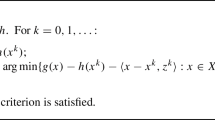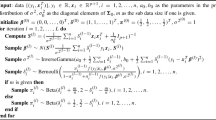Abstract
Under the squared error loss plus linear cost of sampling, we revisit the minimum risk point estimation (MRPE) problem for an unknown normal mean \(\mu\) when the variance \(\sigma ^{2}\) also remains unknown. We begin by defining a new class of purely sequential MRPE methodologies based on a general estimator \(W_{n}\) for \(\sigma\) satisfying a set of conditions in proposing the requisite stopping boundary. Under such appropriate set of sufficient conditions on \(W_{n}\) and a properly constructed associated stopping variable, we show that (i) the normalized stopping time converges in law to a normal distribution (Theorem 3.3), and (ii) the square of such a normalized stopping time is uniformly integrable (Theorem 3.4). These results subsequently lead to an asymptotic second-order expansion of the associated regret function in general (Theorem 4.1). After such general considerations, we include a number of substantial illustrations where we respectively substitute appropriate multiples of Gini’s mean difference and the mean absolute deviation in the place of the general estimator \(W_{n}\). These illustrations show a number of desirable asymptotic first-order and second-order properties under the resulting purely sequential MRPE strategies. We end this discourse by highlighting selected summaries obtained via simulations.
Similar content being viewed by others
References
Abramowitz, M., & Stegun, I. A. (1972). Handbook of mathematical functions, ninth printing. New York: Dover.
Anscombe, F. J. (1950). Sampling theory of the negative binomial and logarithmic series distributions. Biometrika, 37, 358–382.
Anscombe, F. J. (1952). Large-sample theory of sequential estimation. Proceedings of Cambridge Philosophical Society, 48, 600–607.
Anscombe, F. J. (1953). Sequential estimation. Journal of Royal Statistical Society, Series B, 15, 1–29.
Aoshima, M., & Mukhopadhyay, N. (2002). Two-stage estimation of a linear function of normal means with second-order approximations. Sequential Analysis, 21, 109–144.
Babu, G. J., & Rao, C. R. (1992). Expansions for statistics involving the mean absolute deviations. Annals of Institute of Statistical Mathematics, 44, 387–403.
Basu, D. (1955). On statistics independent of a complete sufficient statistic. Sankhyā, 15, 377–380.
Carroll, R. J. (1977). On the asymptotic normality of stopping times based on robust estimators. Sankhyā, Series A, 39, 355–377.
Chattopadhyay, B., & Mukhopadhyay, N. (2013). Two-stage fixed-width confidence intervals for a normal mean in the presence of suspect outliers. Sequential Analysis, 32, 134–157.
Chow, Y. S., & Martinsek, A. T. (1982). Bounded regret of a sequential procedure for estimation of the mean. Annals of Statistics, 10, 909–914.
Chow, Y. S., & Robbins, H. (1965). On the asymptotic theory of fixed-width sequential confidence intervals for the mean. Annals of Mathematical Statistics, 36, 457–462.
Chow, Y. S., & Yu, K. F. (1981). The performance of a sequential procedure for the estimation of the mean. Annals of Statistics, 9, 184–188.
Ghosh, B. K., & Sen, P. K. (1991). Handbook of sequential analysis, edited volume. New York: Dekker.
Ghosh, M., & Mukhopadhyay, N. (1975). Asymptotic normality of stopping times in sequential analysis, unpublished manuscript, Indian Statistical Institute, Calcutta, India.
Ghosh, M., & Mukhopadhyay, N. (1976). On Two fundamental problems of sequential estimation. Sankhyā, Series B, 38, 203–218.
Ghosh, M., & Mukhopadhyay, N. (1979). Sequential point estimation of the mean when the distribution is unspecified. Communications in Statistics-Theory & Methods, Series A, 8, 637–652.
Ghosh, M., & Mukhopadhyay, N. (1980). Sequential point estimation of the difference of two normal means. Annals of Statistics, 8, 221–225.
Ghosh, M., & Mukhopadhyay, N. (1981). Consistency and asymptotic efficiency of two-stage and sequential procedures. Sankhyā, Series A, 43, 220–227.
Ghosh, M., Mukhopadhyay, N., & Sen, P. K. (1997). Sequential estimation. New York: Wiley.
Gini, C. (1914). Sulla Misura della Concertrazione e della Variabilit dei Caratteri. Atti del Reale Istituto Veneto di Scienze, Lettere ed Arti, 73, 1203–1248.
Gini, C. (1921). Measurement of inequality of incomes. Economic Journal, 31, 124–126.
Gut, A. (2012). Anscombe’s theorem 60 years later. Sequential Analysis, 31, 368–396.
Hoeffding, W. (1948). A class of statistics with asymptotically normal distribution. Annals of Mathematical Statistics, 19, 293–325.
Hoeffding, W. (1961). The strong law of large numbers for u-statistics. Institute of Statistics Mimeo Series #302. University of North Carolina, Chapel Hill.
Jurečkovā, J., & Sen, P. K. (1996). Robust Statistical procedures. New York: Wiley.
Lai, T. L., & Siegmund, D. (1977). A nonlinear renewal theory with applications to sequential analysis I. Annals of Statistics, 5, 946–954.
Lai, T. L., & Siegmund, D. (1979). A nonlinear renewal theory with applications to sequential analysis II. Annals of Statistics, 7, 60–76.
Lee, A. J. (1990). U-statistics. Theory and practice. New York: Dekker.
Mukhopadhyay, N. (1975). Sequential methods in estimation and prediction, Ph.D. dissertation, Indian Statistical Institute, Calcutta, India.
Mukhopadhyay, N. (1978). Sequential point estimation of the mean when the distribution is unspecified, Statistics Technical Report Number 312. University of Minnesota, Minneapolis.
Mukhopadhyay, N. (1982). Stein’s Two-Stage Procedure and Exact Consistency, Scandinavian Actuarial Journal 110–122.
Mukhopadhyay, N. (1988). Sequential estimation problems for negative exponential populations. Communications in Statistics-Theory & Methods, Series A, 17, 2471–2506.
Mukhopadhyay, N. (2000). Probability and statistical inference. New York: Dekker.
Mukhopadhyay, N., & Chattopadhyay, B. (2012). A tribute to frank anscombe and random central limit theorem from 1952. Sequential Analysis, 31, 265–277.
Mukhopadhyay, N., Datta, S., & Chattopadhyay, S. (2004). Applied sequential methodologies, edited volume. New York: Dekker.
Mukhopadhyay, N., & de Silva, B. M. (2009). Sequential methods and their applications. Boca Ratton: CRC.
Mukhopadhyay, N., & Hu, J. (2017). Confidence Intervals and point estimators for a normal mean under purely sequential strategies involving Gini’s mean difference and mean absolute deviation. Sequential Analysis, 36, 210–239.
Mukhopadhyay, N., & Hu, J. (2018). Gini’s mean difference and mean absolute deviation based two-stage estimation for a normal mean with known lower bound of variance. Sequential Analysis, 37, 204–221.
Mukhopadhyay, N., & Solanky, T. K. S. (1994). Multistage selection and ranking procedures. New York: Dekker.
Ray, W. D. (1957). Sequential confidence intervals for the mean of a normal population with unknown variance. Journal of Royal Statistical Society, Series B, 19, 133–143.
Robbins, H. (1959). Sequential estimation of the mean of a normal population. In Ulf Grenander (Ed.), Probability and statistics, H Cramér volume (pp. 235–245). Uppsala: Almquist & Wiksell.
Sen, P. K. (1981). Sequential nonparametrics: invariance principles and statistical inference. New York: Wiley.
Sen, P. K. (1985). Theory and applications of sequential nonparametrics, CBMS #49. Philadelphia: SIAM.
Sen, P. K., & Ghosh, M. (1981). Sequential point estimation of estimable parameters based on U-statistics. Sankhyā, Series A, 43, 331–344.
Siegmund, D. (1985). Sequential analysis: Tests and confidence intervals. New York: Springer.
Starr, N. (1966). On the asymptotic efficiency of a sequential procedure for estimating the mean. Annals of Mathematical Statistics, 37, 1173–1185.
Starr, N., & Woodroofe, M. (1969). Remarks on sequential point estimation. Proceedings of National Academy of Sciences, 63, 285–288.
Wiener, N. (1939). The Ergodic theorem. Duke Mathematical Journal, 5, 1–18.
Woodroofe, M. (1977). Second order approximations for sequential point and interval estimation. Annals of Statistics, 5, 984–995.
Woodroofe, M. (1982). Nonlinear renewal theory in sequential analysis, CBMS lecture notes #39. Philadelphia: SIAM.
Zacks, S. (2009). Stage-wise adaptive designs. New York: Wiley.
Zacks, S. (2017). Sample path analysis and distributions of boundary crossing times, lecture notes in mathematics. New York: Springer.
Acknowledgements
The comments received from two anonymous reviewers, the Associate Editor, and the Executive Editor on our earlier version have genuinely helped us in preparing this revised manuscript. We express our gratitude to all of them and thank them.
Author information
Authors and Affiliations
Corresponding author
Ethics declarations
Conflict of interest statement
On behalf of all authors, the corresponding author states that there is no conflict of interest.
Rights and permissions
About this article
Cite this article
Hu, J., Mukhopadhyay, N. Second-order asymptotics in a class of purely sequential minimum risk point estimation (MRPE) methodologies. Jpn J Stat Data Sci 2, 81–104 (2019). https://doi.org/10.1007/s42081-018-0028-0
Received:
Accepted:
Published:
Issue Date:
DOI: https://doi.org/10.1007/s42081-018-0028-0
Keywords
- Asymptotic first-order properties
- Asymptotic second-order properties
- Linear cost
- Regret
- Risk efficiency
- Sequential strategy
- Simulations
- Squared error loss




